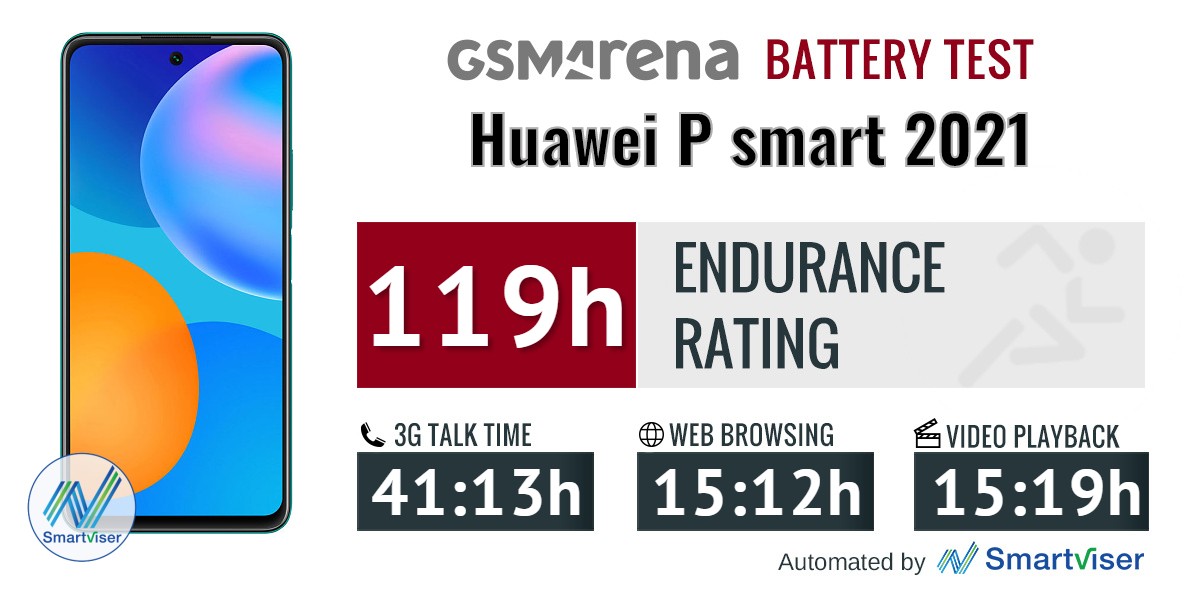Introduction
Sometimes it feels that the turbulent 2020 will never come to an end, but Huawei, for one, is hopeful. Has been so for a while, too - the P smart 2021 was announced a good month ago, and we now have it here with us for review.

Despite its forward-looking name, the smartphone isn't overly innovative, though we didn't expect as much from an iterative update in the entry-level to mid-range segment. Instead, it comes with well-rounded specs at a modest price of sub-€200.
Perhaps that's an appropriate spot to mention that the P smart 2021 also goes by the name Y7a in some markets, with identical specs. Best as we can tell, the only difference is the availability of a 64GB storage option on the Y7a, while the P smart 2021 only comes in 128GB trim. We'll go with 'P smart 2021' for the remainder of this review because that's what it says on our unit's box, but our findings should be equally applicable to the Y7a.
It's also worth noting that Honor has a very similarly specced 10X Lite that also looks a lot like the P smart 2021. We'll be checking that one out too in the coming days.

Anyway, the P smart 2021 features a large 6.67-inch FullHD display, and it's an LCD as opposed to OLED - OLEDs can be had in this price bracket, but not on this one. A Kirin 710A chipset is at the helm here, an in-house design that debuted in 2018 and is a bit long in the tooth, plus the 'A' in the name stands for a 14nm manufacturing process where other 710s were 12nm. The 2 extra nanometers shouldn't be a huge burden, however, and with a 5,000mAh battery inside next year's P smart, we expect solid endurance numbers.
There's also a standard-issue camera setup on the back with a 48MP main unit, complemented by an 8MP ultra-wide and two 2MP modules - one for close-ups and another one for depth detection. An 8MP selfie camera rounds up the imaging department. See - nothing special, but nothing really missing either.
Oh, okay, nothing is missing except Google Play services. Replaced by Huawei's Mobile Services and the AppGallery, getting a Huawei phone these days still means getting your favorite apps and games is not as straightforward as on an Android phone with Google's blessing.
Huawei P smart 2021 specs:
- Body: 165.7x76.9x9.3mm, 206g; Colors: Crush Green, Blush Gold, Midnight Black.
- Display: 6.67" IPS LCD, 1080x2400px resolution, 20:9 aspect ratio, 395ppi.
- Chipset: Kirin 710A (14 nm): Octa-core (4x2.0 GHz Cortex-A73 & 4x1.7 GHz Cortex-A53); Mali-G51 MP4.
- Memory: 128GB 4GB RAM; microSDXC (dedicated slot).
- OS/Software: Android 10, EMUI 10.1, no Google Play Services.
- Rear camera: Wide (main): 48 MP, f/1.8, 26mm, 1/2.0", 0.8µm, PDAF; Ultra wide angle: 8 MP, f/2.4, 120˚; Macro: 2 MP, f/2.4; Depth: 2 MP, f/2.4; LED flash, HDR, panorama.
- Front camera: 8 MP, f/2.0; HDR.
- Video capture: Rear camera: 1080p@60/30fps; Front camera: 1080p@30fps.
- Battery: 5000mAh; Fast charging 22.5W.
- Misc: Fingerprint (side-mounted), accelerometer, proximity, compass, FM radio.
Huawei P smart 2021 unboxing
The P smart 2021 arrives in a white cardboard box like every other Huawei we've had at the office in recent years that's not a Mate. Inside it, you get the bare minimum of items - a USB-A-to-C cable and a power adapter. The adapter supports Huawei SuperCharge at up to 22.5 watts and will be much appreciated when filling up that big 5,000mAh battery.

Design
The P smart 2021 has a contemporary, if not an overly distinctive design. With its plastic back and midframe, the handset has no poshness aspirations but doesn't look or feel cheap either.

Over on the front, the 6.67-inch display is surrounded by a black border that's thicker than what you'd find on a flagship yet entirely in line with competing efforts in the P smart's segment. In fact, the 6.67-inch Poco X3 NFC and Xiaomi Redmi Note 9 Pro have virtually identical bezels and footprints as the Huawei handset. The smaller 6.5-inch Realme 6 and 7 are understandably ever so slightly more compact in footprint, but as bezels go, the P smart 2021 is like every other phone in its price range.

There's a punch-hole cutout for the selfie camera centered at the top end of the display (waterdrop notches are so 2020). It's on the big side of average, but the pre-installed screen protector's sloppy application is more annoying.

Huawei doesn't specify the type of glass used to cover the display, and with the US-China trade clash, it's probably not coming from Corning anyway. We're not into the habit of introducing grooves of any depth into displays (voluntarily, at least), so we can't speak as to its scratch resistance. A screen protector is a good idea on any display regardless of trade name or price, however.

Our review unit is the Crush Green colorway, and it's not unlike the P40's Deep Sea Blue we had at the office earlier this year - it could fool you at a passing glance. Two more color options are available on the P smart - Blush Gold and Midnight Black.

The Honor 10X Lite that we just got in the mail, while closely resembling the P smart 2021, does have a different finish on its back. It's more satin than gloss, and it's another type of Green too - Emerald, as opposed to Crush.
 Huawei P smart 2021 (left) next to Honor 10X Lite
Huawei P smart 2021 (left) next to Honor 10X Lite
The camera cluster on the P smart 2021 includes 4 modules stacked vertically - so one more than the P40, though these aren't remotely of the same caliber. A single LED flash keeps the lenses company, and there's just a '48MP AI quad-camera' insignia, but no Leica badge or lens specifics - it's no flagship, the P smart.

The assembly sticks out only a little, and while the phone will wobble a bit, it's the slightest of wobbles and likely wouldn't bother anyone but the most extreme wobble haters. We wind it negligible.

The plastic frame is colored to match the back hue and has a matte finish. The frame itself doesn't pick up fingerprints, though the glossy back is a more serious offender in this respect - keep a soft cloth handy if you'd like to have your P smart 2019 smudge-free.

Since the handset uses an LCD, an under-display fingerprint sensor is out of the question. Rear-mounted capacitive sensors, on the other hand, aren't fashionable (unless you ask Google, but that's a different topic), and this leaves the P smart 2021 with a side-mounted reader built into the power button on the right.
It's placed in a flattened portion of the frame, so it's easy to find by feel, but it's also where your right thumb falls naturally, so there won't be much searching for it anyway. It also works with a left index finger - and we'd say it's about as reliable as the other way around, which isn't always the case with these side-mounted solutions.

The volume rocker above is plastic too, but clicks positively, no complaints.
On the opposite side of the phone is where you'll find the card tray. It's a triple slot that can accommodate two nano SIMs and a microSD cards. So you're getting a dedicated memory expansion slot, and it's the right kind of memory, as opposed to the NM Huawei tries to push with its high-end phones.

The USB-C port is centered on the bottom of the phone with the trio of audio bits around it. The loudspeaker is on the one side, the primary mic, and the 3.5mm headphone jack on the other. Up top, there's just a secondary mic - sadly, no IR blaster on the P smart 2021.

6.67-inch LCD is adequate for the money
The P smart 2021 packs a fairly large 6.67-inch display - it's the largest P smart to date, for what that's worth. It's an LCD panel with 1080x2400px resolution in a 20:9 aspect ratio for a pixel density of 395ppi.

We measured a maximum brightness of 442nits on the P smart 2021, a relatively modest number, particularly for an LCD. We also didn't see a boost with the adaptive brightness enabled.
Black levels are reasonably well contained, and this results in a contrast of around 1200:1 - about average for a modern-day LCD.
| Display test | 100% brightness | ||
| Black, |
White, |
||
| 0.325 | 437 | 1345:1 | |
| 0.353 | 442 | 1252:1 | |
| 0.425 | 461 | 1085:1 | |
| 0.501 | 515 | 1028:1 | |
| 0.354 | 460 | 1299:1 | |
| 0.515 | 631 | 1225:1 | |
| 0 | 423 | ∞ | |
| 0 | 635 | ∞ | |
| 0 | 413 | ∞ | |
| 0 | 636 | ∞ | |
| 0.355 | 456 | 1285:1 | |
| 0.487 | 616 | 1265:1 | |
| 0.343 | 451 | 1315:1 | |
| 0.31 | 457 | 1474:1 | |
| 0.374 | 526 | 1406:1 | |
Color reproduction is handled in a way that is familiar from previous Huaweis. There are two modes - Natural and Vivid, each with a Default/Warm/Cool selector and a color wheel for custom settings.
The P smart 2021 comes with Vivid mode pre-set out of the box. With the 'Default' setting for color temperature, we measured an average dE2000 of 6.3 for our set of DCI-P3 test swatches, and a noticeable blue shift - white was about 10 units off the target. The 'Warm' setting actually made things worse for white (dE2000 of 12 and a strong green tint) though the average improved marginally to 5.9. However, playing around with the color wheel got us a very accurate white point (dE2000 of 2.0) and a reasonable 2.8 average.
Normal mode is the one for sRGB content, and it's good enough with the 'Default' color temperature - 2.9 average dE2000 and only slightly bluish whites. 'Warm' was markedly worse, yielding a 6.5 average and a very yellow white point. However, with a custom setting on the color wheel, things got as close to perfect as we can hope for - a practically ideal white point and an average dE2000 of 1.1.


Custom setting for sRGB • Custom setting for DCI-P3
The P smart 2021 makes no HDR claims, and indeed its display has no HDR capability.
Huawei P smart 2021 battery life
The P smart 2021 has a 5,000mAh battery inside, a generous capacity in general and more or less the standard for the segment - the Poco X3 NFC has a marginally bigger 5,160mAh cell, the Galaxy A31 and the Realme 7 match Huawei's number.
In our testing, the P smart 2021 fared admirably, exceeding 15 hours in each of our screen-on tests and lasting over 41 hours on a voice call. Standby performance was good too, and all of that added up to an Endurance rating of 119 hours.

Our battery tests were automated thanks to SmartViser, using its viSer App. The endurance rating above denotes how long a single battery charge will last you if you use the Samsung Galaxy S20 Ultra 5G for an hour each of telephony, web browsing, and video playback daily. We've established this usage pattern so that our battery results are comparable across devices in the most common day-to-day tasks. The battery testing procedure is described in detail in case you're interested in the nitty-gritty. You can check out our complete battery test table, where you can see how all of the smartphones we've tested will compare under your own typical use.
Both the Realme 7 and the Poco NFC post slightly higher endurance scores, and both last a bit longer in web browsing than the P smart 2021, but are a tiny bit worse for video playback and not quite there in voice calls. The Galaxy A31, meanwhile, comfortably outlasts the P smart 2021 in botch screen-on tests.
Battery charging
The P smart 2021 comes bundled with a Huawei SuperCharge 22.5W adapter, a reasonable middle ground for a phone in this price bracket. It charges the handset from zero to full in 1:42h, with 42% showing at the half-hour mark. Realmes are champs at charging speeds, particularly in this segment, though Xiaomi competitors are also quicker to top up than the Huawei. Samsung's entries in the class are nowhere as fast, though.
30min charging test (from 0%)
- Realme 6
70% - Xiaomi Redmi Note 9 Pro
63% - Realme 7
58% - Poco X3 NFC
55% - Motorola Moto G9 Plus
54% - Huawei P Smart 2021
42% - Samsung Galaxy A41
38% - Samsung Galaxy A51
35% - Xiaomi Redmi Note 9
31% - Motorola Moto G9 Play
31% - Samsung Galaxy A31
30% - Motorola Moto G8 Power
29%
Time to full charge (from 0%)
- Realme 6
0:51h - Realme 7
1:05h - Xiaomi Redmi Note 9 Pro
1:11h - Poco X3 NFC
1:15h - Motorola Moto G9 Plus
1:15h - Huawei P Smart 2021
1:42h - Samsung Galaxy A41
2:00h - Samsung Galaxy A51
2:14h - Xiaomi Redmi Note 9
2:33h - Motorola Moto G9 Play
2:39h - Samsung Galaxy A31
2:48h
The P smart 2021 has a couple of features to prolong the battery's health over time. One of these is Smart Charge that will delay topping up to 100% depending on your charging habits. Unlike Sony or Asus, there are no settings for this one where you can dial in full charge target times or tie it to your morning alarm - it's just a simple on/off toggle (on by default, by the way). But if the flagship Mate 40 Pro doesn't let you customize that, we wouldn't expect it from the P smart, right?
Smart Battery Capacity is also here - it limits full charges to just short of the battery's top capacity so that your lithium-ion battery doesn't stay at a maximum charge, which is detrimental to its long-term health.
Speaker test
The P smart 2021 has a single speaker firing out of the bottom of the handset - the default setup for the segment, though the Poco X3 NFC and some Motos in this price ballpark have stereo speakers.
The P smart 2021 posted an 'Average' score for loudness in our speaker test. As for quality, the handset is unimpressive and on par with the Realme 6 and the Redmi Note 9. The Moto G8 Power and G Pro and the Poco X3 NFC offer superior listening experience.
Use the Playback controls to listen to the phone sample recordings (best use headphones). We measure the average loudness of the speakers in LUFS. A lower absolute value means a louder sound. A look at the frequency response chart will tell you how far off the ideal "0db" flat line is the reproduction of the bass, treble, and mid frequencies. You can add more phones to compare how they differ. The scores and ratings are not comparable with our older loudspeaker test. Learn more about how we test here.
Audio output quality
We've recently discontinued our audio output quality test.
The reason for that is that most phones that arrived for testing were already excellent in this regard, and whatever difference there was, it was marginal and probably indistinguishable to anything but our lab equipment.
Android and EMUI both at 10, no Google Play Services
The P smart 2021 is another in a long line of Huawei phones that don't get Google's blessing and ship with Android, but not with Google Play Services, and apps dependent on them won't run. The Android version is 10 on this one, as is the in-house EMUI layer - the P smart doesn't get the EMUI 11 we saw on the Mate 40 Pro, though the differences between 10 and 11 are not all that pronounced.

While available, the face unlock on the P smart is only camera-based, so it's not all that secure but will do fine for convenience purposes. Fingerprint recognition is the more secure option, and it's based on the side-mounted capacitive reader we already mentioned on the design page. It's the usual multi-tap process for print enrollment and then smooth sailing for operation with either hand - be it right thumb unlocks or left index finger use.
Like all EMUI-driven devices, you can set up a magazine lockscreen style that changes the picture every time you wake up the screen. Sliding from the bottom will bring out quick shortcuts to some commonly used utilities.





Biometric security • Fingerprint authentication • Face unlock • Magazine lockscreen • Tools
On the homescreen, you will find all of the installed and system apps, but there's a toggle in the settings menu that lets you choose between the standard layout or a homescreen with an app drawer. It's a personal preference, and it's good to be able to choose.
There is a replacement for the Google Feed in this version of EMUI, and it's called Today. On this leftmost page, you will find a Search field, shortcuts to favorite contacts, photos, etc., and a News Feed filled with local news through a service provided by Huawei.





Homescreen • Homescreen style • Folder view • Today
Much like other Huaweis, with big selfie cam cutouts or small ones, the P smart 2021 gets an option in the software to mask it with a black status bar, though that could make for a way thicker status bar that you'd like. A good alternative is to just switch to Dark mode.




Embrace the notch • Hide the notch • Dark mode
The notification shade design is the same as on recent Huawei flagships we've seen - with circular toggles and blue accent color for the On state, very much like on Samsung's One UI and sort of like Google's own Android 10 design. There's a brightness slider (but no auto toggle in immediate reach) and a row of toggles upon the first pull, and you pull down again for more toggles.
Multitasking is handled in a standard way (unlike, say, in Xiaomi's MIUI) - with a horizontally scrollable rolodex. The task switcher allows for split-screen or pop-up mode. Most of the default apps support the pop-up view, but only a few can get into split-screen, and we found that odd. Not to mention, going into split-screen is a bit clunky - you need to open the app in pop-up view, make sure there's the other app you want in split-screen active underneath it (and not the homescreen), and then drag the pop-up view app to the edge of the display.





Notification shade • More toggles • Task switcher • Pop-up view • Split-screen view
The P smart lets you choose between the two main types of navigation available. We'd go for the now-standard swipe-based type where you swipe up for Home, swipe up and stop midway for Task switcher, or swipe from the left or right edge of the screen for Back. You can opt for the classic virtual buttons, of course.
Some bits of custom software in EMUI include the Optimizer app, where you can access shortcuts to storage cleanup, battery settings, blocked numbers, Virus scan powered by Avast, and mobile data usage.
Huawei's Music app offers a way to listen to stored MP3s, and it also includes Huawei's own music streaming service, which provides both free and paid subscription tiers.
Same goes for the proprietary Video app - it plays your local videos, but it also includes Huawei's video streaming service similar to YouTube. Huawei has partnered with the BBC to deliver more interesting content.
Huawei's Health app is pre-installed, and it offers step counting, among many other things. There's a file manager app and a note-taking app.
The gallery is an entirely custom job, too, but it has the usual chronological and albums views plus an AI-powered highlights selection.






Optimizer • Music Player • Video • Files • Health • Gallery
The lack of Google services and consequently support for some key apps from Google itself and third parties has been a pain point for Huawei and its phones for a couple of generations.
To get yourself started, you can also use the Phone Clone app, which will copy everything from your old phone, including all installed apps except for Google's (and some banking apps). The thing is, going that route means you won't get future updates to these apps automatically.
There are indeed multiple app store options that aren't Google's Play Store. Huawei's App Gallery is the primary one, and it has a lot of the apps you'd want, though obviously not all of them - most messengers and social networks are here, some banking apps, some games.
Third party stores can accommodate your app needs too. APKPure works great for free apps and games while its Store page with paid apps just links to the Play Store, which won't work on the P smart. Then there's the Amazon App Store - it has plenty of popular apps - both free and paid. There's the caveat that no matter how you source some apps, they simply won't function without Google Play Services.




Phone Clone • AppGallery • APKPure • Amazon App Store
Alongside the Mate 40 series, Huawei announced the launch of its Google Maps replacement - Petal Maps. The app is available on the P smart 2021 here. It finds businesses and restaurants and whatnot, but its database is not entirely complete. There are outdated business names, and some are missing entirely - at least in our immediate vicinity.
Another issue is that traffic data is incorrect, showing all green everywhere when it's clearly not the case. It's one thing to crowdsource your numbers from everyone with Google Maps on their phones and another to base your info solely on Petal Maps. It's still a very clean interface and a pretty good opening effort from Huawei. We'll give them that.
Synthetic benchmarks
The Kirin 710A that powers the P smart 2021 has a very unusual story. An in-house design by Huawei's HiSilicon subsidiary, the regular Kirin 710 debuted in the summer of 2018 on the nova 3i (or P smart +). It later saw a lot of action in numerous other Huawei and Honor branded handsets - it's a somewhat dated SoC already. Until very recently, it was manufactured by Taiwan-based TSMC on a 12nm fab line.
The ongoing trade conflict between the US and China has had widespread implications for multiple Huawei businesses, so the company has sought to diversify supply lines. As part of that process, it announced earlier this year that the Kirin 710A is its first chip manufactured locally at Shanghai-based Semiconductor Manufacturing International Corp (SMIC). In this 'A' version, it's made on SMIC's 14nm fabrication process.

Small differences in the published specs exist between the two versions. Still rocking the same 2x4 octa-core CPU design, the 710A that's inside the P smart 2021 has its powerful Cortex-A73 cluster capped at 2.0GHz as opposed to the 2.2GHz in the non-A Kirin 710 while the four Cortex-A53 cores can go as high as 1.7GHz, the same value as on the TSMC-produced version. The GPU remains the same Mali-G51 MP4, as far as we can tell.
The P smart 2021 was announced in a single 4GB/128GB RAM and storage version. Its alter-ego, the Y7a, gets that configuration too but is also available with half the storage at 64GB.
In the CPU-centric GeekBench, the P smart 2021 occupies the bottom of the chart for single-core performance. Qualcomm's 66x SoC is a hair above in this test (represented by a couple of Motos and a couple of Realmes), midrange Galaxies with either the Exynos 9611 (A51, M31s) or the modest Helio P65 (A31) are a more noticeable step up. At the same time, higher-tier Helios and 700-series Snapdragons are close to twice as potent as the Kirin in the P smart 2021.
GeekBench 5 (single-core)
Higher is better
- Poco X3 NFC
568 - vivo V20
554 - Realme 6
548 - Realme 7
536 - Realme Narzo 20 Pro
517 - Realme Narzo 20
385 - Samsung Galaxy A31
352 - Samsung Galaxy M31s
349 - Samsung Galaxy A51
347 - Motorola Moto G9 Play
314 - Realme Narzo 20A
314 - Realme 7i
312 - Motorola Moto G8 Power
311 - Huawei P smart 2021 (perf. mode)
302 - Huawei P smart 2021
299
Things don't look quite as bad for the P smart 2021 under multi-core load where it manages to outperform the Galaxies, though that's about all the wins it can get.
GeekBench 5 (multi-core)
Higher is better
- Poco X3 NFC
1777 - Realme 6
1726 - vivo V20
1686 - Realme 7
1681 - Realme Narzo 20 Pro
1666 - Motorola Moto G9 Play
1402 - Realme Narzo 20A
1400 - Motorola Moto G8 Power
1394 - Huawei P smart 2021 (perf. mode)
1334 - Realme Narzo 20
1328 - Huawei P smart 2021
1321 - Realme 7i
1318 - Samsung Galaxy A51
1294 - Samsung Galaxy M31s
1261 - Samsung Galaxy A31
1216
Another small win comes in Antutu, where the P smart 2021 inches ahead of the Galaxy A31. 600-series Snapdragon-powered handsets aren't all that much better, though. Again, the Realme 6 (Helio G90T) and the Realme 7 (G95) are miles ahead, as is the Poco X3 NFC with its Snapdragon 732G.
AnTuTu 8
Higher is better
- Realme 7
292828 - Realme Narzo 20 Pro
291407 - Realme 6
288931 - Poco X3 NFC
283750 - vivo V20
276006 - Realme Narzo 20
193912 - Samsung Galaxy M31s
187863 - Honor 9X
187528 - Samsung Galaxy A51
175363 - Motorola Moto G8 Power
173607 - Realme 7i
172933 - Motorola Moto G9 Play
170064 - Realme Narzo 20A
169543 - Huawei P smart 2021 (perf. mode)
169253 - Huawei P smart 2021
161106 - Samsung Galaxy A31
151815
The GPU is hardly class-leading itself. The Realme 7 and Poco X3 NFC have vastly more powerful GPUs, though the Galaxy A31 is slightly behind the P smart 2021.
GFX Manhattan ES 3.0 (offscreen 1080p)
Higher is better
- Realme 7
54 - Realme Narzo 20 Pro
54 - Realme 6
50 - Poco X3 NFC
44 - vivo V20
42 - Realme Narzo 20
25 - Huawei P30 Lite
21 - Huawei P30 Lite (perf. mode)
21 - Honor 9X
21 - Huawei P smart 2021 (perf. mode)
21 - Huawei P smart 2021
21 - Samsung Galaxy M31s
19 - Motorola Moto G9 Play
19 - Realme Narzo 20A
19 - Realme 7i
19 - Motorola Moto G8 Power
19 - Samsung Galaxy A31
18 - Samsung Galaxy A51
16
GFX Manhattan ES 3.0 (onscreen)
Higher is better
- Realme 6
45 - Realme Narzo 20
44 - Realme 7
42 - Realme Narzo 20 Pro
42 - vivo V20
38 - Poco X3 NFC
33 - Motorola Moto G9 Play
33 - Realme Narzo 20A
33 - Realme 7i
32 - Huawei P30 Lite
19
19
19
18
18
18
17
17
15
GFX Manhattan ES 3.1 (offscreen 1080p)
Higher is better
- Realme 7
34 - Realme Narzo 20 Pro
34 - Poco X3 NFC
33 - vivo V20
31 - Realme 6
31 - Realme Narzo 20
16 - Huawei P smart 2021 (perf. mode)
15 - Huawei P smart 2021
15 - Huawei P30 Lite
14 - Huawei P30 Lite (perf. mode)
14 - Honor 9X
14 - Motorola Moto G9 Play
13 - Realme Narzo 20A
13 - Realme 7i
13 - Samsung Galaxy A31
13 - Motorola Moto G8 Power
13 - Samsung Galaxy M31s
12 - Samsung Galaxy A51
10
GFX Manhattan ES 3.1 (onscreen)
Higher is better
- Realme Narzo 20
32 - Realme 7
28 - Realme Narzo 20 Pro
28 - Poco X3 NFC
27 - vivo V20
27 - Realme 6
27 - Motorola Moto G9 Play
26 - Realme Narzo 20A
26 - Realme 7i
25 - Samsung Galaxy M31s
14 - Huawei P30 Lite
13 - Huawei P30 Lite (perf. mode)
13 - Huawei P smart 2021 (perf. mode)
13 - Huawei P smart 2021
13 - Honor 9X
12 - Samsung Galaxy A31
12 - Motorola Moto G8 Power
12 - Samsung Galaxy A51
8.9
3DMark SSE ES 3.1 (offscreen 1440p)
Higher is better
- Realme 7
2709 - Poco X3 NFC
2689 - Realme Narzo 20 Pro
2683 - vivo V20
2593 - Realme 6
2570 - Samsung Galaxy A51
1574 - Realme Narzo 20
1400 - Motorola Moto G9 Play
1169 - Samsung Galaxy A31
1150 - Samsung Galaxy M31s
1092 - Huawei P smart 2021 (perf. mode)
1090 - Huawei P smart 2021
1088 - Realme Narzo 20A
1065 - Huawei P30 Lite
969 - Huawei P30 Lite (perf. mode)
969
3DMark SSE Vulkan 1.0 (offscreen 1440p)
Higher is better
- Realme 7
2772 - Realme Narzo 20 Pro
2735 - Realme 6
2619 - Poco X3 NFC
2495 - vivo V20
2451 - Samsung Galaxy A51
1554 - Realme Narzo 20
1382 - Huawei P30 Lite
1374 - Huawei P30 Lite (perf. mode)
1374 - Realme Narzo 20A
1111 - Motorola Moto G9 Play
1103 - Huawei P smart 2021 (perf. mode)
1062 - Huawei P smart 2021
1060 - Samsung Galaxy M31s
1013 - Samsung Galaxy A31
894
The great thing about a relatively low-performing chipset is that it doesn't throttle much under sustained load, and we saw no real degradation in the P smart 2021's performance with repeated benchmark runs. We did observe the occasional hiccup in daily use, but it's not something we couldn't live with.
2+2 cameras on the back
The P smart 2021 comes with a quad-camera setup on its back, though as is common practice in the lower market segments, only two of them are 'real' cameras.
The main module uses a 48MP Quad Bayer sensor - what has become the go-to option for even the lower mid-tier devices. A non-stabilized 26mm equivalent lens with an f/1.8 aperture sits in front of it.
The ultra wide-angle cam has an 8MP sensor with a lens that has the field of view of a 17mm lens on a 35mm film camera. The aperture on this one is f/2.4.

Then there's the 2MP fixed-focus 'macro' camera that works best at a focusing distance of 4cm. Another 2MP unit for depth detection completes the list.
The P smart uses Huawei's camera app that is more or less the same among all lineup models. The zoom selector complaint we've been having with it is less of an issue on this one, simply because of the phone's having fewer cameras, but its placement remains sub-optimal. Navigation is otherwise standard - you change modes by sliding the mode selector to the side (but not by swiping in the viewfinder). There's a toggle for changing between the front and rear cameras (but not by swiping in the viewfinder).
There's a Pro mode too, which is also the same as on the flagships - you don't get that approach with every brand. Here you can adjust parameters yourself - ISO (50 to 3200), shutter speed (1/4000s to 30s), exposure compensation (-4 to +4EV in 1/3 stop increments), and white balance (presets and specific light temperature). You can also choose the metering mode (matrix, center-weighted, and spot) and the focus mode (single, continuous, and manual). If the phone thinks you messed up the exposure, an icon will pop up to warn you.
Huawei's approach to faux bokeh has been two-fold for years - there's both a Portrait mode and an Aperture mode. In Aperture, you can choose the simulated aperture in the range from f/0.95 to f/16. Post shot, you can change the aperture and the desired focus point within the Gallery.
In Portrait mode, you can enable and disable the background blur, but you can also choose the bokeh shapes - circles, hearts, or discs. You can add some beautification on a scale from 0 to 10, but the simulated lighting we last saw on the Mate 40 Pro isn't available on the P smart 2021.
Image quality
In daylight, the P smart 2021 takes decent photos with its main camera - not amazing, but entirely in line with our expectations for this class of a phone. The detail is good, and the noise is very well controlled. Sloping straight edges do have pretty strong aliasing, and sharpness drops towards the corners, but neither is a deal-breaker and overall pixel-peeping the photos leaves a positive impression.
Taking a step back, we see somewhat muted colors - we'd prefer a livelier output than what the phone delivers. Dynamic range is also not a strong suit of the P smart 2021 - we'd rank it on the lower side of average.
Master AI works subtly. We found it to deepen the blue in the skies when it detects a 'blue sky' scene. On the other hand, 'Greenery' didn't make much difference with the greenery in our test scenes.






Daylight samples, main camera, Master AI
The native 48MP resolution is accessed from the 'More' pane in the mode selector, so it's a few swipes and a couple of taps away. It does bring benefits in terms of recorded detail. However, in addition to the usual requirement for plenty of light, there's something else at play here which we can't quite pinpoint - the last two samples in this set are noticeably more detailed while the other four have that upscaled and sharpened look. The charts we shoot in our studio for our Photo compare tool are of the sharp variety, too.






Daylight samples, main camera, 48MP
The ultra-wide cam of the P smart 2021 is an unpretentious 8MP unit. Detail levels are predictably modest and on par with other 8MP ultra wides in the segment like the Realme 7 and the Galaxy A31. Having said that, the 13MP ultra-wide camera of the Poco X3 NFC is vastly superior to all three of these.
Back to the P smart, it continues with its subdued colors here. Dynamic range is relatively narrow, and the phone tends to expose a little darker than ideal, too.






Daylight samples, ultra wide angle camera
In low light, the P smart 2021 takes decent pictures. Dynamic range is very limited, and it shows incredibly well in scenes with mixed lighting like samples 1, 5, and 6 below. However, in more balanced lighting, it's less of an issue. The resolved detail is actually pretty good where there's enough light to illuminate it, while noise is relatively prominent in the darker areas. Since there wasn't much color saturation in daylight, to begin with, it's no wonder that colors are quite dull in low-light.






Low-light samples, main camera
Night mode does change things quite dramatically, however. It brings massive improvements in dynamic range, and you can count on much better development in both shadows and highlights. You'll also get much-improved color saturation. The trade-offs include increased noise levels and the fact that Night mode images are captured at 8MP - trade-offs we'd easily live with.






Low-light samples, main camera, Night mode
There's no Night mode for the ultra wide-angle cam, however, and that's close to unusable in the dark. It produces soft images with a very narrow dynamic range that are more often than not underexposed.






Low-light samples, ultra wide angle camera
Once you're done with the real world samples, head over to our Photo compare tool to see how the Huawei P smart 2021 stacks up against the competition.



Huawei P smart 2021 against the Poco X3 NFC and the Realme 7 (Global) in our Photo compare tool
Portraits
As usual, the P smart 2021 has a Portrait mode for people only and an Aperture mode for people and other subjects. In both modes, the phone does reasonably well in terms of subject separation, though you could spot imperfections in the border areas when looking up close. The f/2.0 simulated aperture we picked for our Aperture mode samples makes for a bit of an exaggerated bokeh effect, while the default blur level in Portrait mode looks more natural. Dynamic range is similarly narrow in both modes - there's not enough computing power for bokeh and HDR calcs at the same time, we gather.
You can shoot non-humans in Aperture mode too, to a mixed level of success. For example, in the street sign shot, we appreciate the naturally blurred rendition of the building outline in the background - a lot of other phones draw a sharp edge where the building meets the sky. But then the sign itself isn't entirely sharp itself.




Aperture samples, non-human subjects
The P smart 2021's macro cam takes low-res 2MP close-ups that still do manage to capture decent detail. The thing is, though, that you can get the same detail if you shoot on the main cam in 12MP and crop to match the macro cam's frame. And if you opt for the 48MP mode, you get even more detail.
Selfies
The 8MP selfie camera hardware looks unimpressive in the spec sheet, but the P smart 2021 does manage to squeeze decent images out of it. The detail is adequate, colors, and skin tones, in particular, are really pleasing too. Once again, the dynamic range isn't great, though.
That last bit also gets worse in portrait mode, so backlit shots will inevitably result in blown highlights as the phone tends to expose for the subject - generally a good thing since that's you, after all. Subject separation is pretty good - no clipped ears, though there is the occasional mix-up with jawlines and clothes.
Video recording
The P smart 2021 isn't too well equipped to record video. It maxes out at 1080p resolution, where it can capture at 60fps or 30fps on the main cam and only 30fps on the ultra-wide. There's no 4K recording capability. There's also no video stabilization, which feels properly pre-historic. You do get to choose between the default h.264 codec or the more storage-efficient h.265, for what that's worth.
Video quality is barely okay in 1080p at 30fps from the main cam - we're talking relatively nice colors, average detail, and limited dynamic range. 1080p at 60fps suffers from poor focus - it will hunt to acquire, miss, and stay out of focus.
Ultra wide footage is soft and comes with dull colors and an additional drop in dynamic range.
With no EIS available, hand-held footage is quite shaky. We'd go ahead and say that shooting while walking is a no-go.
Here's a glimpse of how the Huawei P smart 2021 compares to rivals in our Video compare tool. Head over there for the complete picture.



Huawei P smart 2021 against the Poco X3 NFC and the Realme 7 (Global) in our Video compare tool
Competition
The P smart 2021 faces some tough opponents from brands with budget segment pedigree. Realme 7, for example, has been on our mind from the get-go. It comes with a vastly more powerful chipset and a 90Hz display that's also brighter than the P smart's 60Hz one. The Realme adds NFC to the list of features, plus it can record 4K video. With battery life similarly great between the two and a tie for the I/O basics (headphone jack and dedicated microSD slot), the Realme is looking like a much better package.

Most of the above applies to the Poco X3 NFC, and then some. The Poco, too, has an HRR screen, and this one goes all the way to 120Hz. It also delivers an overall superior camera experience to what the P smart 2021 can muster - better ultra-wide, 4K video with stabilization. It then adds stereo speakers and IP53-rated splash proofing, plus an aluminum frame for a touch of 'premium.' The X3 NFC is about 10% more expensive. In its base trim level, it comes with half the P smart's storage, not to mention it uses a shared memory slot, while the P Smart 2021 has a dedicated one. Even so, we'd pick the Poco out of these two.
If you're after a more familiar brand name, Samsung has the Galaxy A31 for you at a modest premium over the P smart 2021's asking price. The Galaxy's display may not be HRR, but this one has a different advantage - it's AMOLED next to the P smart's LCD and it's also brighter on top of that. The Galaxy outlasts the P smart in an endurance race, but those are about the only things it does better, really. It's mostly a tie in performance and image quality, which shows that the brand name itself commands a premium.
Another brand with a famed past, Motorola doesn't charge all that much of a premium. In fact, the Moto G8 Power can be had for less than the P smart 2021. That will net you a proper tri-set of cameras, including a tele, and even if they're not amazing, they're still superior to the P smart's setup. The Moto also has even longer battery life and brighter and contrasty display, plus stereo speakers, though it too isn't a computing powerhouse.




Realme 7 (Global) • Xiaomi Poco X3 NFC • Samsung Galaxy A31 • Motorola Moto G8 Power
Verdict
Huawei's attempt at predicting the future with the P smart 2021 isn't entirely failed - it's not a bad phone, and with the right carrier subsidy, could make a fine daily driver for a less demanding user. It's got properly excellent battery life, a decent camera system, and a display that gets very accurate with a minor tweak.
But some issues prevent us from recommending the P smart 2021. First and foremost, that's obviously the lack of Google Play Services - the Huawei AppGallery selection is wide and ever-growing, but it's still no Play Store. The chipset might have been reasonably powerful in 2018, but there are better options today, sadly unavailable to Huawei for the same reason Google isn't on board. The SoC is probably responsible for the lack of 4K video and stabilization in 1080p, and that's one too many drawbacks.

Then comes the fact that there are several handsets at the P smart's price point that beat it in one key area or another, or even across the board. All things considered, unless your carrier makes a particularly exciting offer on the Huawei P smart 2021, our advice would be to look elsewhere.
Pros
- Excellent battery life, reasonably fast charging.
- Potentially super color-accurate display.
- Okay camera output overall, nice night mode on the main cam, good selfies.
- 3.5mm jack, FM radio, standalone microSD slot.
Cons
- No Google services on board - even if there are workarounds and most apps will work, some won't.
- Relatively dim display, 60Hz too, when others offer 90Hz or even 120Hz at this price point.
- Dated chipset, underpowered compared to rivals.
- Poor video recording capabilities - no 4K, no stabilization.









































0 Response to "Huawei Y7a / P smart 2021 review"
Post a Comment